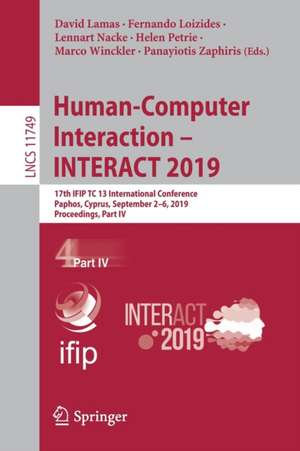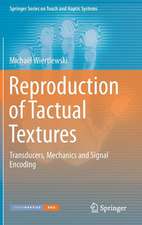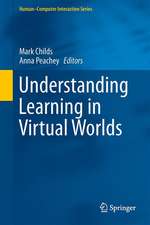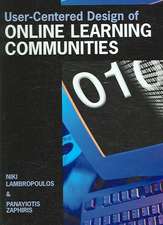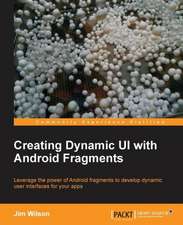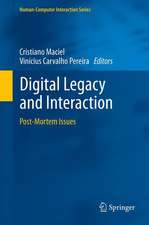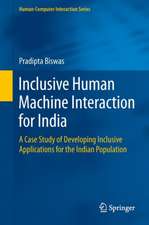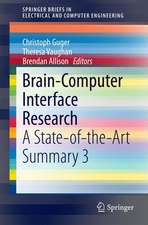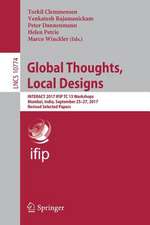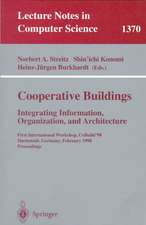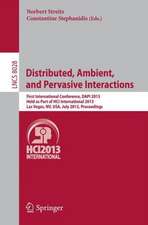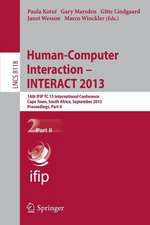Human-Computer Interaction – INTERACT 2019: 17th IFIP TC 13 International Conference, Paphos, Cyprus, September 2–6, 2019, Proceedings, Part IV: Lecture Notes in Computer Science, cartea 11749
Editat de David Lamas, Fernando Loizides, Lennart Nacke, Helen Petrie, Marco Winckler, Panayiotis Zaphirisen Limba Engleză Paperback – 29 aug 2019
Part I: accessibility design principles; assistive technology for cognition and neurodevelopment disorders; assistive technology for mobility and rehabilitation; assistive technology for visually impaired; co-design and design methods; crowdsourcing and collaborative work; cyber security and e-voting systems; design methods; design principles for safety/critical systems.
Part II: e-commerce; education and HCI curriculum I; education and HCI curriculum II; eye-gaze interaction; games and gamification; human-robot interaction and 3D interaction; information visualization; information visualization and augmented reality; interaction design for culture and development I.
Part III: interaction design for culture and development II; interaction design for culture and development III; interaction in public spaces; interaction techniques for writing and drawing; methods for user studies; mobile HCI; personalization and recommender systems; pointing, touch, gesture and speech-based interaction techniques; social networks and social media interaction.
Part IV: user modelling and user studies; user experience; users’ emotions, feelings and perception; virtual and augmented reality I; virtual and augmented reality II; wearable and tangible interaction; courses; demonstrations and installations; industry case studies; interactive posters; panels; workshops.
The chapter ‘Experiencing Materialized Reading: Individuals’ Encounters with Books’ is open access under a CC BY 4.0 license at link.springer.com.
The chapter ‘What Is Beautiful Continues to Be Good: People Images and Algorithmic Inferences on Physical Attractiveness’ is open access under a CC BY 4.0 license at link.springer.com.
| Toate formatele și edițiile | Preț | Express |
|---|---|---|
| Paperback (4) | 671.02 lei 6-8 săpt. | |
| Springer International Publishing – 25 aug 2019 | 671.02 lei 6-8 săpt. | |
| Springer International Publishing – 25 aug 2019 | 671.85 lei 6-8 săpt. | |
| Springer International Publishing – 29 aug 2019 | 1017.65 lei 6-8 săpt. | |
| Springer International Publishing – 29 aug 2019 | 1018.98 lei 6-8 săpt. |
Din seria Lecture Notes in Computer Science
- 20%
 Preț: 1061.55 lei
Preț: 1061.55 lei - 20%
 Preț: 307.71 lei
Preț: 307.71 lei - 20%
 Preț: 438.69 lei
Preț: 438.69 lei - 20%
 Preț: 579.30 lei
Preț: 579.30 lei -
 Preț: 410.88 lei
Preț: 410.88 lei - 17%
 Preț: 427.22 lei
Preț: 427.22 lei - 20%
 Preț: 596.46 lei
Preț: 596.46 lei - 15%
 Preț: 448.04 lei
Preț: 448.04 lei - 20%
 Preț: 353.50 lei
Preț: 353.50 lei -
 Preț: 389.49 lei
Preț: 389.49 lei - 20%
 Preț: 309.90 lei
Preț: 309.90 lei - 20%
 Preț: 645.28 lei
Preț: 645.28 lei - 20%
 Preț: 763.23 lei
Preț: 763.23 lei - 15%
 Preț: 580.46 lei
Preț: 580.46 lei - 20%
 Preț: 310.28 lei
Preț: 310.28 lei - 20%
 Preț: 655.02 lei
Preț: 655.02 lei - 20%
 Preț: 1183.14 lei
Preț: 1183.14 lei - 20%
 Preț: 340.32 lei
Preț: 340.32 lei -
 Preț: 449.57 lei
Preț: 449.57 lei - 20%
 Preț: 591.51 lei
Preț: 591.51 lei - 18%
 Preț: 938.83 lei
Preț: 938.83 lei - 20%
 Preț: 337.00 lei
Preț: 337.00 lei - 20%
 Preț: 649.50 lei
Preț: 649.50 lei - 20%
 Preț: 607.40 lei
Preț: 607.40 lei - 20%
 Preț: 1414.79 lei
Preț: 1414.79 lei - 20%
 Preț: 1024.44 lei
Preț: 1024.44 lei - 20%
 Preț: 583.40 lei
Preț: 583.40 lei - 20%
 Preț: 453.32 lei
Preț: 453.32 lei - 20%
 Preț: 575.49 lei
Preț: 575.49 lei - 20%
 Preț: 1075.26 lei
Preț: 1075.26 lei - 20%
 Preț: 585.88 lei
Preț: 585.88 lei - 20%
 Preț: 825.93 lei
Preț: 825.93 lei - 17%
 Preț: 360.20 lei
Preț: 360.20 lei - 20%
 Preț: 763.23 lei
Preț: 763.23 lei - 20%
 Preț: 340.32 lei
Preț: 340.32 lei - 20%
 Preț: 504.58 lei
Preț: 504.58 lei - 20%
 Preț: 369.13 lei
Preț: 369.13 lei - 20%
 Preț: 580.93 lei
Preț: 580.93 lei - 20%
 Preț: 343.62 lei
Preț: 343.62 lei - 20%
 Preț: 350.21 lei
Preț: 350.21 lei - 20%
 Preț: 583.40 lei
Preț: 583.40 lei - 20%
 Preț: 583.40 lei
Preț: 583.40 lei - 15%
 Preț: 438.59 lei
Preț: 438.59 lei - 20%
 Preț: 341.95 lei
Preț: 341.95 lei - 20%
 Preț: 238.01 lei
Preț: 238.01 lei - 20%
 Preț: 538.30 lei
Preț: 538.30 lei
Preț: 1017.65 lei
Preț vechi: 1272.06 lei
-20% Nou
Puncte Express: 1526
Preț estimativ în valută:
194.75€ • 202.57$ • 160.78£
194.75€ • 202.57$ • 160.78£
Carte tipărită la comandă
Livrare economică 15-29 aprilie
Preluare comenzi: 021 569.72.76
Specificații
ISBN-13: 9783030293895
ISBN-10: 3030293890
Pagini: 766
Ilustrații: XXXIV, 766 p. 225 illus., 173 illus. in color.
Dimensiuni: 155 x 235 mm
Greutate: 1.1 kg
Ediția:1st ed. 2019
Editura: Springer International Publishing
Colecția Springer
Seriile Lecture Notes in Computer Science, Information Systems and Applications, incl. Internet/Web, and HCI
Locul publicării:Cham, Switzerland
ISBN-10: 3030293890
Pagini: 766
Ilustrații: XXXIV, 766 p. 225 illus., 173 illus. in color.
Dimensiuni: 155 x 235 mm
Greutate: 1.1 kg
Ediția:1st ed. 2019
Editura: Springer International Publishing
Colecția Springer
Seriile Lecture Notes in Computer Science, Information Systems and Applications, incl. Internet/Web, and HCI
Locul publicării:Cham, Switzerland
Cuprins
User Modelling and User Studies.- An Analysis of (Non-)Use Practices and Decisions of Internet of Things.- Analysis of utilization in the message card production by use of fusion character of handwriting and typeface.- Communicating User Insights with Travel Mindsets and Experience Personas in Intra-City Bus Context.- Effects of Age-Related Cognitive Decline on Elderly User Interactions with Voice-Based Dialogue Systems.- GDI as an alternative guiding interaction style for Occasional users.- User Experience.- A Novel Method to Build and Validate an Affective State Prediction Model from Touch-Typing.- Acceptability of Persuasive Prompts to Induce Behavioral Change in People Suffering from Depression.- The UX construct – does the usage context influence the outcome of user experience evaluations?.- User Experience of Driver State Visualizations: a Look at Demographics and Personalities.- Users' Emotions, Feelings and Perception.- As Light As Your Scent: Effects ofSmell and Sound on Body Image Perception.- Experiencing Materialized Reading: Individuals' Encounters with Books.- “I Kept Browsing and Browsing, But Still Couldn’t Find the One”: Salient Factors and Challenges in Online Typeface Selection.- Integrating a Binaural Beat into the Soundscape for the Alleviation of Feelings.- What is Beautiful Continues to be Good: People Images and Algorithmic Inferences on Physical Attractiveness.- Virtual and Augmented Reality I.- Design and evaluation of three interaction models for manipulating Internet of Things (IoT) devices in Virtual Reality.- Head Mounted Display Interaction Evaluation: Manipulating Virtual Objects in Augmented Reality.- On the Use of Persistent Spatial Points for Deploying Path Navigation in Augmented Reality: An Evaluation Study.- User Experience Guidelines for Designing HMD Extended Reality Applications.- Virtual and Augmented Reality II.- Am I Moving Along A Curve? A Study On Bicycle Traveling-In-Place Techniques In Virtual Environments.- Design and Evaluation of an Augmented Reality App for Learning Geometric Shapes in 3D.- Enhance Engine Room Diagnostics Through Audio-Focused VR Simulation.- Head-controlled Menu in Mixed Reality with a HMD.- VR Interaction Modalities for the Evaluation of Technical Device Prototypes.- Wearable and Tangible Interaction.- Combining Tablets with Smartphones for Data Analytics.- COMMONS: a board game for enhancing interdisciplinary collaboration when developing health and activity-related wearable devices.- On-Body Tangible Interaction: Using the Body to Support Tangible Manipulations for Immersive Environments.- SplitSlider: A Tangible Interface to Input Uncertainty.- The possibility of personality extraction using skeletal information in hip-hop dance by human or machine.- Courses.- Introduction to Automation and to its Potential for Interactive Systems Design.- Introduction to Data Visualization.- The Science behind User Experience Design.-Demonstrations and installations.- A Multitouch Drawing Application with Occlusion-free Interaction Strategies.- CityCompass VR - A Collaborative Virtual Language Learning Environment.- GazeMotive: A Gaze-based Motivation-aware E-learning Tool for Students with Learning Difficulties.- Hybrid Wireless Sensor Networks: a Prototype?.- Memories of Carvalhal’s Palace: Haunted Encounters, a Museum Experience to Engage Teenagers.- Multi-level Engagement in Augmented Reality Children’s Picture Books.- On-the-Fly Usability Evaluation of Mobile Adaptive UIs through Instant User Feedback.- SwipeBuddy - A teleoperated tablet and ebook-reader holder for a hands-free interaction.- VibroSquare: Vibro-Tactile Display for Body-Centric Implicit Interactions.- Industry Case Studies.- A Human-centred Business Scenario in SIoT - The Case of DANOS Framework.- A Method and Tool for Analyzing Usability Testing Data in the Business Sector.- Applying UCD for Designing Learning Experiences for Romanian Preschoolers. A case study.- Developing a User Interface for an Ultrasound Device Designed for Midwives and General Health Practitioners Situated in Low Resource Nations and Communities.- It AIn’t Nuttin’ New – Interaction Design Practice After the AI Hype.- R++, User-Friendly Statistical Software.- Towards a Framework for the Classification of Usability Issues.- Interactive Posters.- A Mobile App for Illiterate and Semi-Illiterate Pregnant Women- A User Centered Design Approach.- Adding Images to Psychometric Questionnaires to Improve User Engagement.- Applications for In-situ Feedback on Social Network Notifications.- Combating Misinformation Through Nudging.- Exploring the Application of Social Robots in Understanding Bullying Perpetrators.- Initial Steps Towards Infrastructuring Body-Centric Computing.- Model-driven Framework for Human Machine Interaction Design in Industry 4.0.- MyCompanion: A Digital Social Companion for Assisted Living.- OmniWedges: Improved Radar-Based Audience Selection for Social Networks.- Reducing Anxiety for Dental Visits.- SCAH!RF: a Novel Wearable as a Subconscious Approach for Mitigating Anxiety Symptoms.- Search results on flight booking websites: Displaying departure and return flights on a single page vs two consecutive pages.- Smart Objects for Speech Therapies at Home.- Transparency heuristic: Effect of implicitness of online data acquisition on sensitivity perception.- Using Virtual Reality to Enable Individuals with Severe Visual Disabilities to Read Books.- Vibro-Tactile Implicit Interactions: So What?.- Visualizations of user’s paths to discover usability problems.- Word Association: Engagement of Teenagers in a Co-design Process.- Panels.- Social Media and the Digital Enterprise.- User Experience in an Automated World.- Workshops.- Challenging Misinformation: Exploring Limits and Approaches.- Designing for Aging People.- HCI Challenges in Human Movement Analysis.- The Human(s) in the Loop - Bringing AI and HCI Together.- Visualizing Information Retrieved from (large) WHAT Networks.- #SociallyAcceptableHCI: Social Acceptability of Emerging Technologies and Novel Interaction Paradigms.- Pushing the Boundaries of Participatory Design.- User Experiences and Wellbeing at Work.- Handling Security, Usability, User Experience and Reliability in User-Centered Development Processes.
